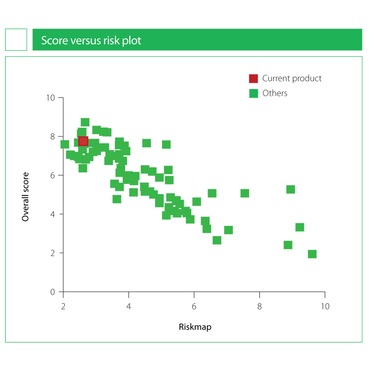
Barclays six-year defensive autocall linked to the FTSE 100
Returns on this defensive autocall are linked to the FTSE 100 subject to a trigger level lower than the strike. The product pays no commission, in line with the UK’s Retail Distribution Review, and offers returns of up to 7% a year

Barclays has issued a six-year growth product linked to the FTSE 100 Index, which has been designed to meet the UK's Retail Distribution Review (RDR) environment in that it does not include adviser commission. Compared with traditional commission-based structured products, this product has higher headline rates, making it suitable for fee-based advisers and investors. It is issued as a warrant-linked note, which makes it easier for the product to be listed and bought on a platform. Capital is returned at maturity only if the final index level finishes at 50% or above its initial level on the final day of investment.
UK providers had prepared for the RDR deadline of December 31, 2012, with many adjusting their products to meet the non-commission requirements. New generation, RDR-ready plans will be available through self-invested personal pension (SIPP) providers, stockbrokers or popular investment platforms.
The B019 FTSE Autocall 90 plan offers potential returns of 7% per annum (not compounded) if the FTSE 100 is at or above 90% of its initial index level at any annual observation point from the third year onwards.
If the closing level of the index is at or above 90% of its initial level on any annual review date from the third year, the product will kick out.
If kickout occurs at the third, fourth, fifth or sixth anniversary, the return levels are 21%, 28%, 35% and 42%, respectively. If the closing level of the index is not at or above 90% of its initial level on an anniversary, the product continues until the trigger level is reached on subsequent anniversaries or to the end of the six-year term.
If kickout does not occur and the trigger level is not reached on the final observation date, the capital returned to the investor depends on whether the final index level is below the barrier of 50%. If the final level finishes at or above the barrier of 50% on the final market reading, capital is protected and the investor receives the full return of capital at maturity. If, however, the final level of the index finishes below the 50% barrier level at maturity, the amount of capital returned to the investor is reduced by one percent for each percentage fall of the index from its initial level.
This is not a 50% American barrier that is observed on every trading day throughout the term. If the American barrier is breached, the capital is at risk and will be lost unless the underlying asset recovers to at least 100% of its initial level at maturity. Here, the full return of investor's capital will depend on whether the final index level remains above or equal to the 50% of its initial value. If the index is below 50%, the investor will lose a large amount of capital, depending on the barrier level.
The probability of the product kicking out at the third, fourth, fifth or sixth anniversary is 72.77%, 7.45%, 4.32%, and 1.86%, respectively. The probability calculations tell us that if the product is to mature early, it is more likely to do so during its early stages. The probability of kickout not occurring is 13.6%.
This investment can only be purchased through an investment platform. The product is designed to be held to maturity. However, the investment can be bought and sold prior to maturity through the platform as Barclays will quote daily buy and sell prices. During the term, the market value of the product will depend on various market factors, such as volatility, interest rates, spot value of the index, dividend rates and time left to maturity. Returns made outside of an individual savings account or SIPP are likely to be subject to capital gains tax, according to the product literature.
Pricing and risk
Autocallable products give an opportunity to reach a target level and receive a known return if kickout occurs. The popularity of the defensive autocall products, in which the trigger level is set lower from the strike level, has increased during 2012. Because of the nature of autocall products with multiple maturities, it is not possible to split the pricing into components as with the other product types. The value of the autocall product depends on the fixed returns and their likelihood, as well as the downside risk if autocall does not occur.
A PDF of this article with additional data tables is available here



The information in this analysis is taken from sources which Future Value Consultants Limited deems reliable but no guarantee is made that the information is complete or accurate and it should not be relied upon as such. Any opinions in the analyses represent those of Future Value Consultants Limited at the time of writing but are subject to change. All valuations and prices shown are indicative only and do not imply an offer or commitment of any kind. The analysis does not constitute advice or recommendations nor should it be relied upon for any purpose. No liability whatsoever is accepted by Future Value Consultants Limited or Structured Products magazine for any loss or expense incurred from using this analysis.
Only users who have a paid subscription or are part of a corporate subscription are able to print or copy content.
To access these options, along with all other subscription benefits, please contact info@risk.net or view our subscription options here: http://subscriptions.risk.net/subscribe
You are currently unable to print this content. Please contact info@risk.net to find out more.
You are currently unable to copy this content. Please contact info@risk.net to find out more.
Copyright Infopro Digital Limited. All rights reserved.
As outlined in our terms and conditions, https://www.infopro-digital.com/terms-and-conditions/subscriptions/ (point 2.4), printing is limited to a single copy.
If you would like to purchase additional rights please email info@risk.net
Copyright Infopro Digital Limited. All rights reserved.
You may share this content using our article tools. As outlined in our terms and conditions, https://www.infopro-digital.com/terms-and-conditions/subscriptions/ (clause 2.4), an Authorised User may only make one copy of the materials for their own personal use. You must also comply with the restrictions in clause 2.5.
If you would like to purchase additional rights please email info@risk.net
More on Structured products
A guide to home equity investments: the untapped real estate asset class
This report covers the investment opportunity in untapped home equity and the growth of HEIs, and outlines why the current macroeconomic environment presents a unique inflection point for credit-oriented investors to invest in HEIs
Podcast: Claudio Albanese on how bad models survive
Darwin’s theory of natural selection could help quants detect flawed models and strategies
Range accruals under spotlight as Taiwan prepares for FRTB
Taiwanese banks review viability of products offering options on long-dated rates
Structured products gain favour among Chinese enterprises
The Chinese government’s flagship national strategy for the advancement of regional connectivity – the Belt and Road Initiative – continues to encourage the outward expansion of Chinese state-owned enterprises (SOEs). Here, Guotai Junan International…
Structured notes – Transforming risk into opportunities
Global markets have experienced a period of extreme volatility in response to acute concerns over the economic impact of the Covid‑19 pandemic. Numerix explores what this means for traders, issuers, risk managers and investors as the structured products…
Structured products – Transforming risk into opportunities
The structured product market is one of the most dynamic and complex of all, offering a multitude of benefits to investors. But increased regulation, intense competition and heightened volatility have become the new normal in financial markets, creating…
Increased adoption and innovation are driving the structured products market
To help better understand the challenges and opportunities a range of firms face when operating in this business, the current trends and future of structured products, and how the digital evolution is impacting the market, Numerix’s Ilja Faerman, senior…
Structured products – The ART of risk transfer
Exploring the risk thrown up by autocallables has created a new family of structured products, offering diversification to investors while allowing their manufacturers room to extend their portfolios, writes Manvir Nijhar, co-head of equities and equity…







